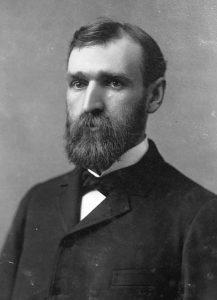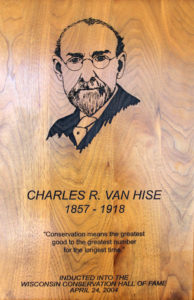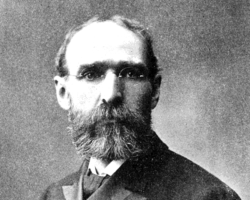1857 – 1918
Inducted 2004
 “Conservation means the greatest good to the greatest number for the longest time.” – Van Hise
“Conservation means the greatest good to the greatest number for the longest time.” – Van Hise
Charles R. Van Hise is probably known best for leading the University of Wisconsin-Madison during the Progressive Era at the birth of the 20th Century. Here he embraced “The Wisconsin Idea,” one of the foundation blocks of the Progressive Era. The Wisconsin Idea said that, “The boundaries of the campus extend to the boundaries of the state.” It advocated applying the university’s best and brightest minds to improve the lives of ordinary people. The idea helped lead to state funding of UW Extension, set up to serve people across the state, and development of a state university system to help keep the promise of access and affordability to Wisconsin’s residents. It is little wonder that UW-Madison would produce so many conservation leaders among its faculty and student bodies in the 20th century. Van Hise set the example.
Van Hise was also a major contributor to conservation in the United States and the world. His 1910 book, Conservation of Natural Resources in the United States, is recognized as one of the most important works in the history of conservation. It was the most respected, influential and often-cited general survey of conservation issues published in its time. In the book, Van Hise pointed the finger at individualism for depletion of natural resources. He called for living in a way that does not diminish the quality of life for unborn generations.
 Born on a farm in Fulton, Rock County, Van Hise was a classmate and friend of Robert M. “Fighting Bob” La Follette at UW-Madison. La Follette was governor of Wisconsin when he helped his friend become president of UW-Madison in 1903. Van Hise served as president until the year of his death, 1918. First, though, Van Hise would earn his credentials as a field geologist, and as a faculty member at UW-Madison. He began the latter in 1879.
Born on a farm in Fulton, Rock County, Van Hise was a classmate and friend of Robert M. “Fighting Bob” La Follette at UW-Madison. La Follette was governor of Wisconsin when he helped his friend become president of UW-Madison in 1903. Van Hise served as president until the year of his death, 1918. First, though, Van Hise would earn his credentials as a field geologist, and as a faculty member at UW-Madison. He began the latter in 1879.
Van Hise embraced “The Wisconsin Idea,” one of the foundation blocks of the Progressive Era. The Wisconsin Idea said that, “The boundaries of the campus extend to the boundaries of the state.” It advocated applying the university’s best and brightest minds to improve the lives of ordinary people. The idea helped lead to state funding of UW Extension, set up to serve people across the state, and development of a state university system to help keep the promise of access and affordability to Wisconsin’s residents.
Van Hise’s conservation contributions are right in line with progressive thought, and conservation gains are among the enduring accomplishments of that era. Remarkable is the fact that while serving as president of UW-Madison, he was also a major voice in the earliest moments of understanding about the urgent need for good conservation. He spoke quite clearly then, even if the world was not quite ready to listen. About his major conservation work, he wrote: “It is my hope that this book may serve a useful purpose in forwarding the great movement of conservation which, as it seems to me from the point of view of the not distant future of the human race, is more important than all other movements now before the people.”
It is little wonder that UW-Madison would produce so many conservation leaders among its faculty and student bodies in the 20th century. Van Hise set the example.
Resources
Charles Van Hise Legislative Citation
Charles Van Hise 2004 WCHF Induction Remarks, by Bill Berry
The Future of Man in America by Charles R. Van Hise from the World’s Work
The Remarkable Legacy of the Wisconsin School of Precambrian Geology by Robert H. Dott, Jr. from Geoscience Wisconsin, 2001
A Van Hise Centennial by Robert H. Dott from The Outcrop, 2002
Out of the Classroom, Into the Community article from UW-Madison Alumni Park website
Influential UW President Charles Van Hise radio program from WORT
Lake Superior Legacy Collection from UW-Extension includes links to several Van Hise publications
Charles R. Van Hise, 1857-1918, tribute by A. W. Schorger (WCHF Inductee) for Wiscosin Conservation Bulletin
Photos
These images may be used under the Creative Commons Attribution-NonCommercial-NoDerivatives 4.0 International License.









